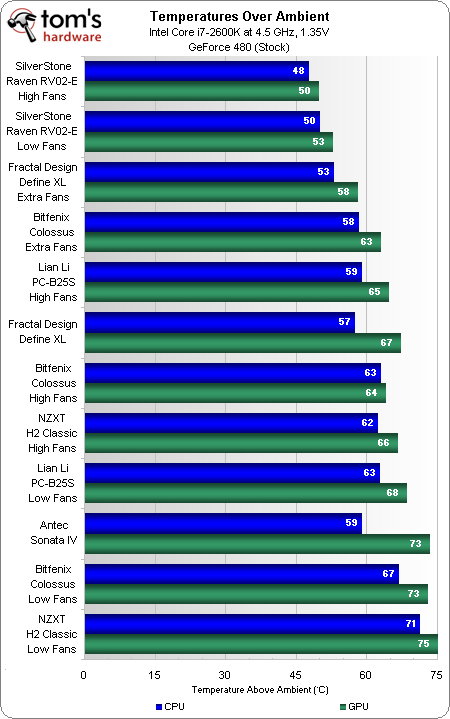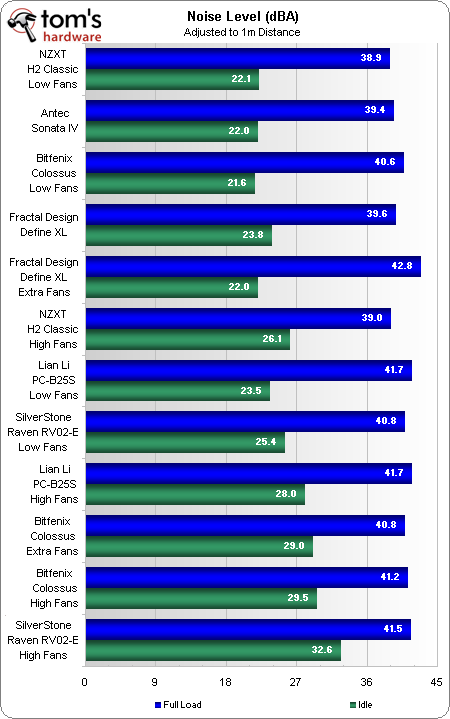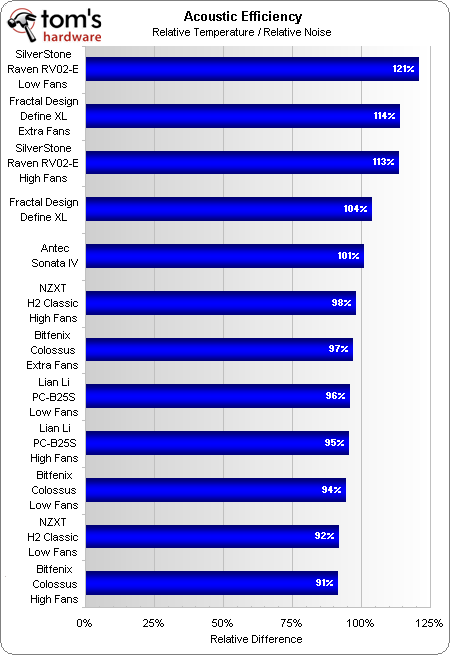Six Low-Noise, Performance-Oriented Cases, Tested
We recently illustrated the features of our six low-noise cases, and today we get to find out how those features help them perform. We provide further detail on the hardware installation process before delving into heat and noise comparisons.
Benchmark Results: Noise And Heat
The primary goal of a performance case is to reduce heat, while the primary goal of a quiet case is to minimize noise. The cases in this review were designed to deliver the best combination of both attributes, muffling the ruckus of extra-hot parts.
Of course, SilverStone’s gaming-oriented case presents us with the lowest temperatures. This is, after all, a chassis designed for enthusiast-class hardware that happens to have some noise-reducing features. More specifically designed for noise reduction, Fractal Design’s Define XL takes second place in thermal management.
The hottest configuration in our first chart, NZXT’s H2 Classic at low fan speeds, tops our noise-suppression chart. What happens when we compare noise to heat?
The average temperature of the CPU and GPU in our first chart was 62° Celsius over ambient, while the average noise level of our second card was 33.1 decibels. Dividing each case’s average temperature by the average of all cases gives us a relative temperature score, with the coolest case on top, while dividing the average noise of each case by the average of all cases gives us a relative noise score, with the noisiest case on the bottom. The resulting acoustic efficiency table below is also relative, since its class average refers only to the configurations in today’s test.
With bottom-mounted intake fans its only real noise-reducing feature, SilverStone’s non-insulated RV02-E takes a surprise win. Of course, that only happens when its fans are turned to the lowest setting. But that lowest setting also took second place in our thermal tests. In other words, we suggest the RV02-E owners maintain their sanity and use the lowest fan speed whenever possible.
Just as surprising is how Fractal Design’s noise-optimized design takes second place only when we add a side-intake fan and a second front-intake fan. Of course, the opened-up side hole made this the least-attractive option at full GPU load, so we’d probably choose the stock configuration instead.
Get Tom's Hardware's best news and in-depth reviews, straight to your inbox.
Current page: Benchmark Results: Noise And Heat
Prev Page Test System Configuration Next Page Conclusion-
the rv03 is out at less $$$ you guys should do a rv02-E vs rv03 round in the cooling side and thats because the rv03 has more fansReply
-
dragonsqrrl Using a SilverStone Fortress Series FT02B-W here. Basically identical interior design, except in my opinion the exterior is more aesthetically pleasing. Glad to confirm the excellent cooling characteristics.Reply
http://www.newegg.com/Product/Product.aspx?Item=N82E16811163161&cm_re=ft02_b-_-11-163-161-_-Product
Another big plus with the Fortress 2 is the inclusion of sound dampening foam on every panel, but to be entirely honest with you, due to the open nature of the case, I'm really not sure how much sound it's actually dampening. -
xmaswraith 34.5 gigahertz? 34.5 gigahertz? Great Scott!Reply
Marty, I'm sorry. But the only power source capable of generating 34.5 gigahertz of electricity is a bolt of lightning... (begin back to the future theme song!) -
JOSHSKORN henryvalz34.5 Ghz...Hell, yes! About time, pushing those extreme overclocks!I bet they were overclocking from Pluto.Reply -
killerclick JOSHSKORNI bet they were overclocking from Pluto.Reply
Didn't you watch the news? Astronomers sent a dwarf in a rocket to remove Pluto so it doesn't exist anymore. -
madsbs Yet, as a gaming case, the Raven 2 Evolution may not fulfill the aesthetic or storage needs of some computing professionalsReply



